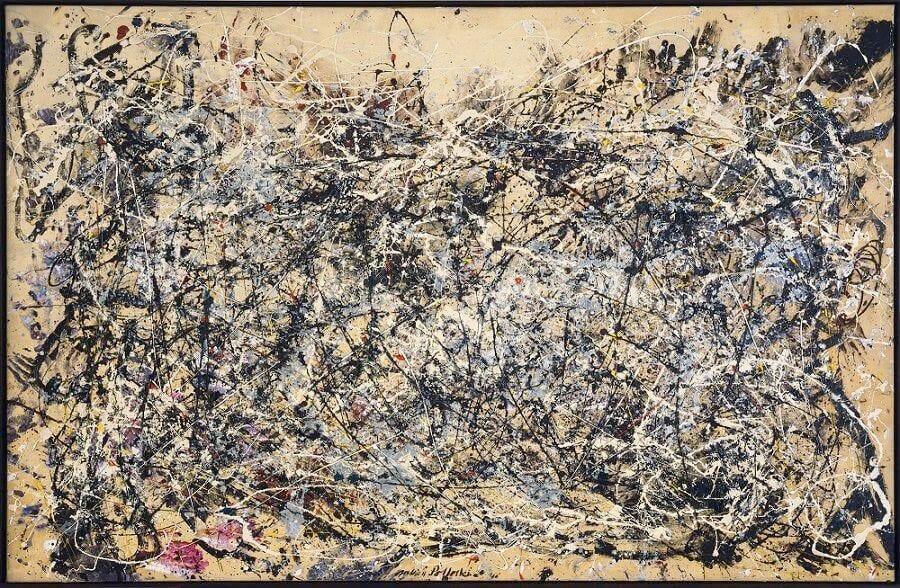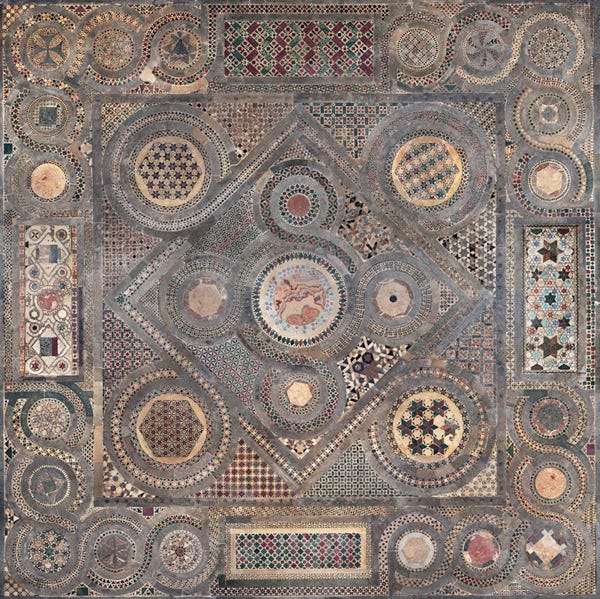Welcome to my Substack, Ornament - a place where I will be writing about the broad spectrum of decorative art objects, from ceramics, furniture, textiles, silver, armour, jewellery and combinations of some of the above. If you are interested, please subscribe to my free monthly newsletter. The aim of this first post is to introduce the concept of Ornament, looking at the categorisation of decorative arts, and how it compares to the fine arts. In future I will be writing on subjects that interest me, from hardstones to funerary effigies, furniture and mounted porcelain, as well as occasional exhibition and book reviews. Please also feel free to leave me your comments, I welcome the discussion.
Ornament. What are the decorative arts?
> ‘Every room that will admit of it is filled with antique busts, urns, vases, mosaic pavement, Roman tiles, & every curiosity that could possibly be procured by the late Lord Carlisle. Indian chests & cabinets, the most rich, in which ornament rather than convenience has been consulted’. Sir Harbottle Grimston, MS, ‘A Northern Tour from St. Albans’, 1768, HMC Verulam, 64 (1906) pp. 236-37
The 18th century was not renowned as an period of restraint in collecting fashions. The magnificently named Sir Harbottle Grimston, singled out certain objects seen by him at Castle Howard in 1768 for he noticed that it was ornamentation that was the primary consideration of the object - not function, or convenience. This illustrates the point about the decorative arts - they were on the whole designed for convenience or function, at least that was often the starting point for the designer or maker, but these objects are often in fact dominated by or subsumed into pattern and decoration.
What are 'the decorative arts'? As the name suggests, such objects provide decoration, ornamentation, a presence. A distinction is often drawn between the fine arts, the decorative (sometimes also referred to as the applied) arts, and architecture. The fine arts - its name implying a (higher) degree of refinement than the sister arts - comprise painting in oils, pastels and watercolours, print-making, drawing, and also sculpture and medals. Architecture is fairly self-explanatory, often incorporating and serving as a backdrop to the fine and decorative arts. The decorative arts, then would include eveything else of a visual nature other than film and the performing arts, comprising such broad categories as jewellery, silver, furniture, tapestries, carpets, fashion and other textiles, armour, ceramics, glass, clocks, and all manner of hybridised categories such as the remarkable multi-media works created in the workshops of Carl Faberge. In the Renaissance, the debate around which of the arts was considered first or most important, restricted to painting, sculpture and architecture was called the paragone. Ornament is not an attempt to revive that discussion, but is perhaps something closer to an apology for the decorative arts.
Inevitably such a consideration as this may have emerged from old-fashioned structures imposed on museums, the art market and beyond, but such structures and their associated boundaries persist today, and while the snobbery of years past has gone, the appreciation of great works of decorative arts still today lags behind great works of fine art - especially in the art market and the exhibitions market. Looked at through value or price, an important but subjective and rather unscientific, or anti-scholarly approach, fine art - in particular certain types of painting (eg pictures by Picasso or Cezanne) - is miles ahead. If value is a signifier of appreciation (and extrinsic worth), it is therefore especially the case in the art market that appreciation of objects of decorative art lag behind the fine arts: for only the last 3 centuries, the prices of great works of fine art have exceeded master works of decorative art, prior to about 1700 great works of decorative art (for example tapestries) were considerably more highly prized than paintings and drawings, and what we today, loosely, call fine art. And the names we give these categories are recent having evolved from the traditional practice of art history which emerged after the publication of Jakob Burckhardt's writings including such classics of cultural history as The Civilization of the Renaissance in Italy (1860).
The Big Questions
But rather than a (probably rather pedantic) discussion around the naming of parts and why art history has treated decorative arts less favourably than the fine arts, I would suggest that a more stimulating debate can be had around asking some questions. Over lunch with a fellow curator in The Metropolitan Museum of Art in New York (at that time we were both curators of collections of decorative arts) I asked how we should think about how to present objects in our care, many of which no longer function in the way that they were originally intended. His reply was to 'ask the big questions' - by which I think he meant how do we live? what do we do around death? How do we remember people, events, animals, objects? What role does commerce, necessity, the impact of scientific discovery, warfare, migration, changes in national boundaries etc play in the creation of these objects which we now gather together and describe as 'decorative art'? And perhaps (to me most interestingly) what do these objects tell us about our species' shared humanity? Maybe these questions can be more easily answered via the medium of painting, or through theatrical performances or film or the printed word which may explain the comparative popularity of those media. It is often also the case that in Western society the more profound the response or depth of feeling in the viewer the more highly regarded the work of art: for example paintings by Mark Rothko.
But what is it about the decorative arts which makes it so much harder to consider the big questions which seem to be the province of the two-dimensional fine arts of painting, drawing and print-making? Are Jackson Pollock's large-scale 'drip' paintings - in some ways a form of pattern - considered to be more profound than the 13th century 'cosmati' pavement before the high altar of Westminster Abbey? The comparison is an unfair one, and both are products of societes seprated by seven centuries. But a key significance attached to each work - not the only significant element - is the person behind each work: in the case of Pollock's drip paintings there is a visceral proximity to the artist himself through the 'arena' of the painting - the energy with which he created the work in the 1950s is palpable.
Jackson Pollock, Number 1A, 1948, MoMA, New York (© The Pollock-Krasner Foundation ARS, NY and DACS, London 2022)
In the case of the 'cosmati' pavement in Westminster Abbey, the abstract, geometric designs created through the tesserae reflect the design conventions of the time, but knowing that the exact place itself has been used for the coronation of kings and queens of England and the United Kingdom brings the object into a direct link with the mystical union of English (later British) monarchs with their people and God, and gives it a special power.
The Great 'Cosmati' pavement at Westminster Abbey. Restored in 2010. (© Dean and Chapter of Westminster Abbey)
Function and beauty
Looked at another way, the decorative arts have two principal uses: as objects invented for a specific use (a spoon for eating; a chair for sitting; a clock for telling the time), and second to provide decoration, beauty, to provoke curiosity. Function and ornament. Both these uses are evident in two key strands which underpin the decorative arts: on one side is the minimalist, modernist design concept pursued at the Bauhaus, where the mantra 'form follows function' dominated; and on the other side, is 'maximalist' exuberance, seen in the magnificent European palaces built in Europe in the early modern period. The galaxy of palaces built in Dresden by Augustus the Strong are good examples, but there are many more to choose from: Schloss Favorite, Versailles, Chatsworth, the Vatican. Both traditions follow the essential functionalism required of the object, but treat the object very differently, one tradition raising function above all, the other subverting it, sometimes losing the original function entirely.
Both strands in the decorative arts (functionalism and maximalism) require equal consideration. To think seriously about objects, either individual pieces of furniture, ceramics, textiles, silver etc. or the thoughtful assemblage of objects into a collection, can we ask questions such as what do these objects tell us about the people who made, ordered, used or later collected them? What is their real function, either as individual (sometimes performative) pieces, or do they function as part of a collective whole as essential parts of an interior, along with paintings, sculpture and the sister arts? How do they work? Why were they made or ordered? Under what conditions did the creative spirit descend ? We must consider commerce, warfare and conquest, migration, necessity, religion, travel, state or political requirements and so on : the cause and effects of these interactions of peoples have so often provided the conditions of great art.
Great works of art?
Finally, why are certain objects considered to be a 'great work of art' (e.g. the 'Badminton Cabinet'? Perhaps this could be termed 'The National Gallery' or 'Waverley' question (i.e. the criteria export of works of art from the UK, and acceptance in lieu)? By which is meant - would such and such work of art qualify for inclusion in the National Collection of Art ? In a very general sense this is probably the wrong question to ask. This is no criticism of the Waverley Criteria which are necessary in the narrow setting where those criteria are applied and used to good effect. Therefore, when thinking about decorative arts (in contra distinction to the fine arts) might it be more useful to ask, why should we spend time thinking about this work of art? What is that sets it apart from other objects of its type? What does it tell us that other pieces cannot? Asking and debating these questions should be hard, and may go some way to understanding how and why we perceive objects.
This is the first in a series of short, monthly articles discussing aspects of the decorative arts, and will include other subjects whcih interest me including art market commentary, exhibition and book reviews. Please feel free to comment below.
If you are interested and want to know more, please subscribe. Thank you.





